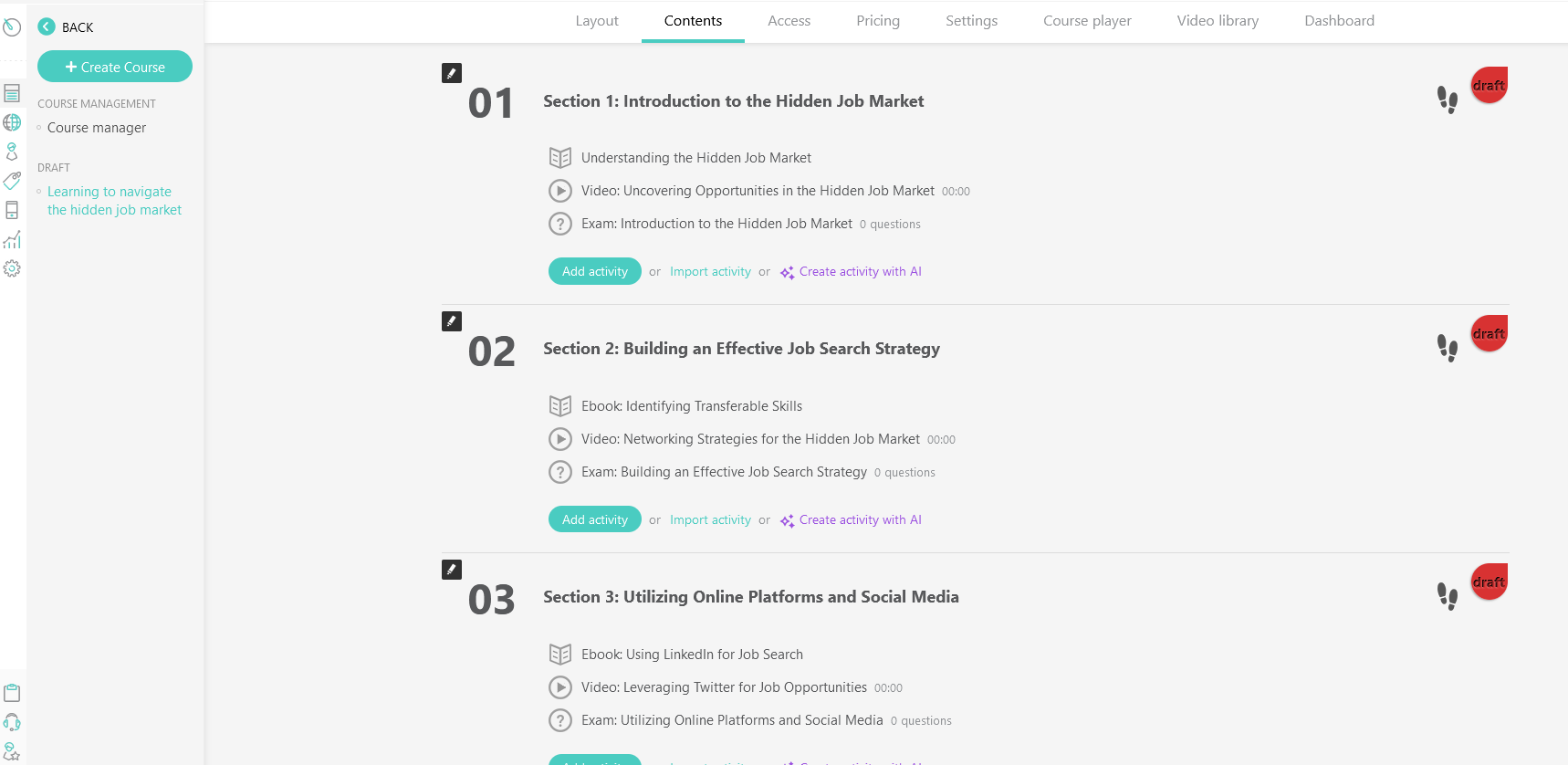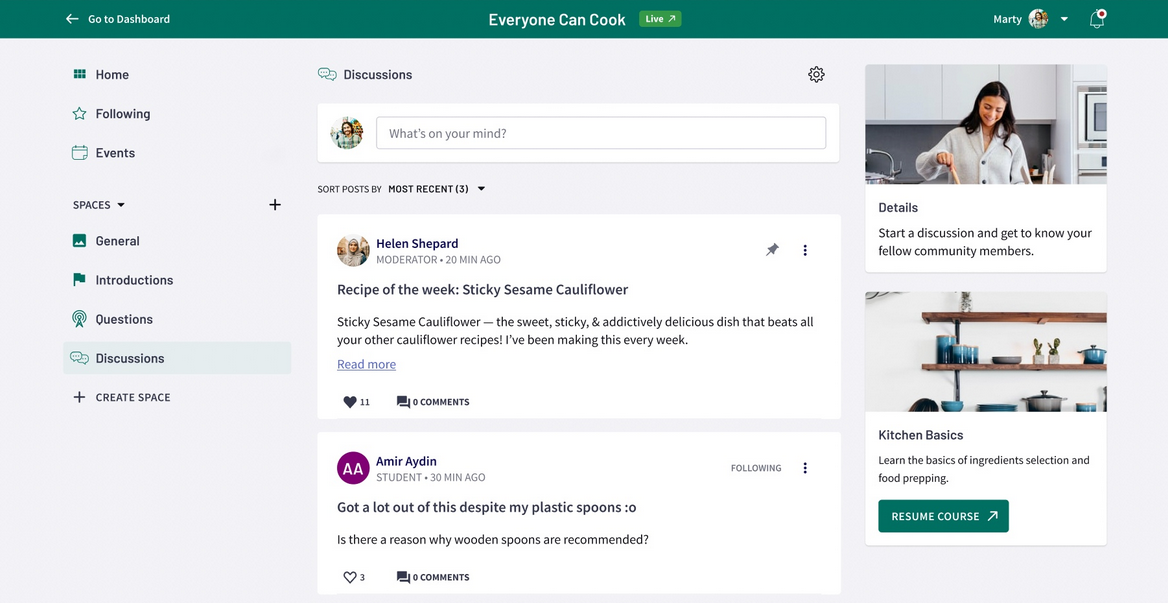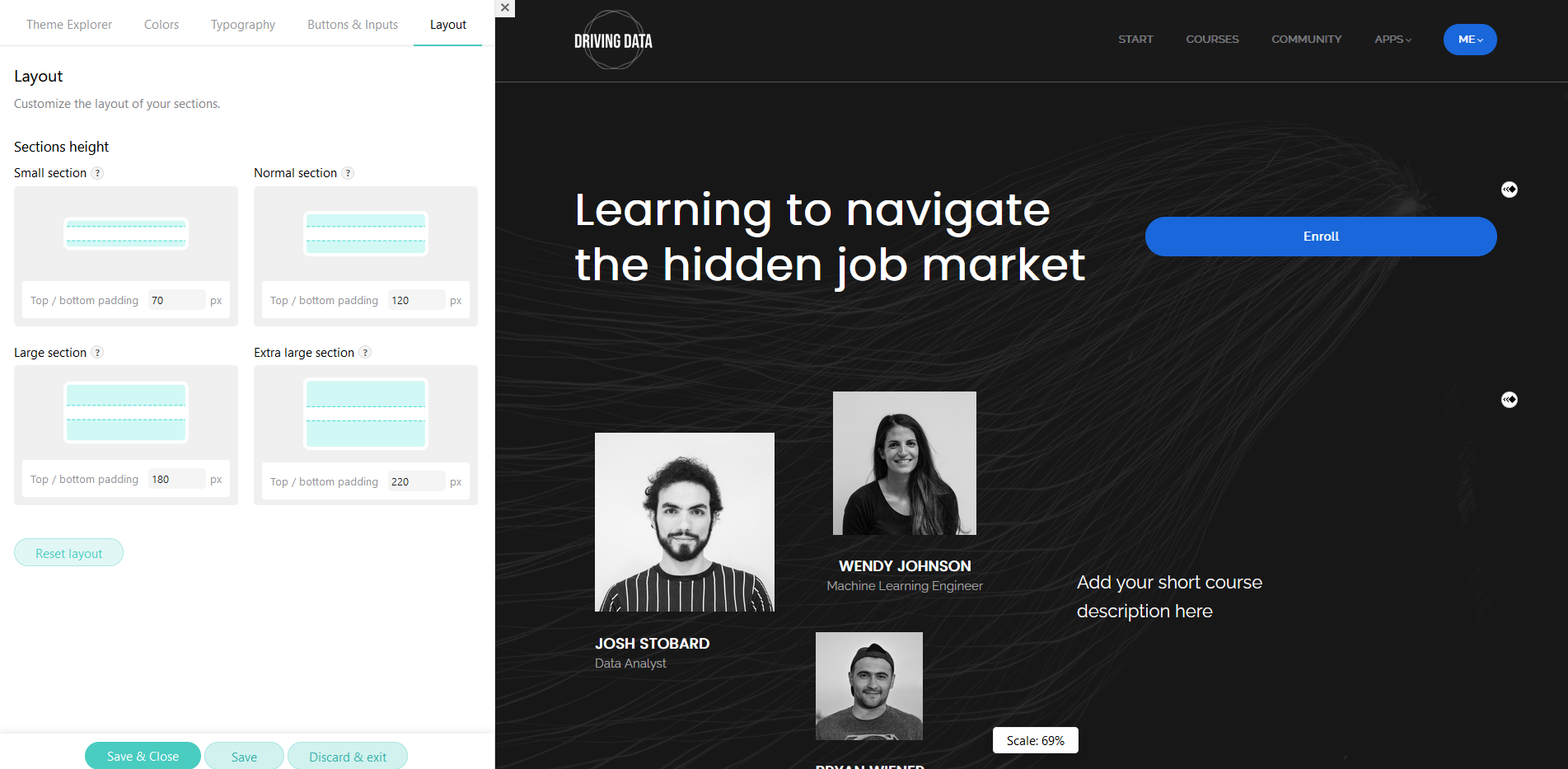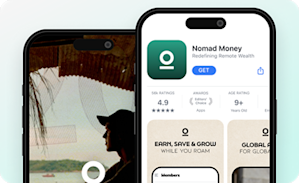Online Courses
LearnWorlds vs. Thinkific
We compare LearnWorlds and Thinkific to help you choose the better course platform for your business.
Author
Mighty Team
Last Updated
March 28, 2025

Table of Contents
LearnWorlds was launched in 2014 and has grown into a strong course platform directed at institutional learning. Thinkific launched in 2014 and is known for pre-recorded courses for creators and online business owners.
In this article, we’ll compare LearnWorlds and Thinkific for creating and delivering online courses. We’ll explore what each gives you, ranking their strengths and weaknesses across these features:
Online course platform
Communities and engagement tools
Business and marketing features
Apps and access
Try the platform with the most $1 million memberships
LearnWorlds vs. Thinkific: Comparison Table
LearnWorlds | Thinkific | |
|---|---|---|
Asynchronous Courses | ||
Exam Question Types | 16 | 1 (multiple choice quiz) |
AI Quiz Generator | - | |
Website Templates | 50 | 12 |
Community Forums | Basic | Basic |
All-In-One Communities | - | - |
Native Livestreaming | - | - |
Integrated Basic Email | ||
AI Email Marketing | - | |
App Included | - | |
White-Label Apps |
Pricing
Thinkific
$49/mo - Basic
$74/mo - Start
$149/mo - Grow
LearnWorlds
$24/mo + $5 for each course sale - Starter
$79/mo - Pro Trainer
$249/mo - Learning Center
Thinkific vs LearnWorlds
Course Platform
LearnWorlds
LearnWorlds has developed a reputation as a solid course platform. It offers a SCORM-compliant Learning Management System (LMS) with the options to drip content, customize learning paths, and integrate a few AI features.
As of writing, the AI features are built around creating and editing your course and website content. The features really shine for video courses, which adds in AI transcripts, interactive points in course videos, and–of course–the option to organize and stick lessons to a table of contents.

One of LearnWorld’s best features is the assignment builder which can build evaluations with 16 types of questions, banks for reusable questions, customizable summary screens for feedback and test results, and SCORM assessment integration. It even has a survey tool for collecting feedback from students.
Thinkific
As a course platform, Thinkific also offers a drag-and-drop course builder that has audio, video, PDF, and interactive file support for course material.
Like LearnWorlds, you can add quizzes, assignments, and exams. Thinkific is adding AI features in the area of evaluation, so you can generate quiz questions–which is a cool idea.
Thinkific courses can include self-paced or scheduled classes, and you can create certificates. The course-builder also has AI tools built into it for generating course content, and you can integrate externally hosted content or upload bulk content. Finally, Thinkific has unlimited video hosting.
Which is better?
Both platforms are strongest on their LMS features–specifically for asynchronous courses. So it’s difficult to pick a clear winner in this category. You’ll need to compare the differences below to understand what each offers as a total platform.
But here’s a quick summary.
LearnWorlds is slightly better as a course platform. It has more power, more customization, more features that would be good for institutional learning. Most notably, it has a lot more power and flexibility for delivering exams and evaluations.
BUT, LearnWorlds is overkill for many course creators. Thinkific offers a perfectly good set of features for asynchronous learning, and many of the advanced features of LearnWorlds wouldn’t apply to many course creators.
For the group of course creators who want SCORM compliance, both platforms are technically SCORM compliant. You can import SCORM-friendly files.
Communities & Engagement
LearnWorlds
LearnWorlds is adding some capabilities around live courses. While not done with native features, LearnWorlds has 3 integrations which they say make it possible to create great live experiences: Zoom, WebEx, and Calendly. Adding these integrations allows for 1:1 and group video, live sessions, and attendance management. These live events can be added to courses as learning activities too.

LearnWorlds is extremely weak on community features, though. The discussion forum features are clunky. Technically they include spaces, but the community forum function feels dated. As such, LearnWorlds is really not built for live courses and course communities–it’s strongest as an asynchronous course platform.
Thinkific
Thinkific also has the option to add basic course communities, which include @ mentions, notifications, and discussion threads. You can divide content into spaces dedicated to different themes or topics, and there’s a “trending posts” feature to let your members know what’s hot. There’s image, video, file, and link posting in the community.

And it can be connected to live lessons or coaching for a course. But like LearnWorlds, Thinkific is missing native livestreaming. It suggests different options like Zoom or YouTube to integrate a livestream into a course–potentially adding complications.
Finally, Thinkific has added some basic community analytics and an evangelist program to encourage your supermembers to promote the community.
Which is better?
Neither of these platforms were built for communities and live engagement. Neither have native livestreaming, and both require a bunch of integrations to make live instruction or online communities actually work.
For communities, Thinkific comes out slightly ahead. It does have more to offer for community-building, but its forum features with some spaces and mentioning tools are still a far cry from software designed to be a community platform.
If you want community and courses together, neither of these options are a good choice. We’ll get to this more below.
Business & Marketing
LearnWorlds
LearnWorlds gives you options to build your course under your own branding. You can also create a course website with drag-and-drop design or over 400 templates to choose from. And if that’s not enough, you can incorporate custom design code. The landing pages can be built to integrate popups and forms, and LearnWorlds even has a basic email tool for running sales.

It has support for offering your own affiliate program (and monitor with an affiliate dashboard as well as a few pre-set course funnels for sales sequences). You can bundle courses with other things to sell memberships, subscriptions, or other digital products or offer in-app purchases.
Thinkific
Like LearnWorlds, Thinkific also has numerous customizable website themes and a landing page builder. You can build multiple page types into your course, and like LearnWorlds it has custom domain support and advanced HTML/CSS customization.
For monetization, you can bundle course sales with memberships, subscriptions, or other digital downloads like eBooks. There’s support for 100+ currencies and Thinkific’s payment processing. You can include affiliate programs with Thinkific, as well as coupons, gifts, and group orders.
One unique marketing feature that Thinkific has added is AI email tools: AI prompts to help with email marketing. This is a neat feature that can help to scale your email outreach.
Which is better?
This one is a tie. Both platforms have comparable features for building landing pages. Technically LearnWorlds has more: more website templates, more integrations, more admin options (on the most expensive plans), and a few more features. But whether or not this matters to you depends on what you need.
Thinkific is simpler, but still has lots of power for running your own business and marketing. Its email tool is better.
LearnWorlds is more advanced in other marketing tools (while still pretty user-friendly), which may have specific integrations or tools for some teachers.
Apps and Access
LearnWorlds
LearnWorlds offers a DIY approach to app design, with a drag-and-drop app editor that works with the website editor. You can create a branded course app with LearnWorlds.
But there are a couple downsides to LearnWorlds’ approach to apps that you should understand:
LearnWorlds’ doesn’t have a native app under its brand. There’s no LearnWorlds’ app included. If you want to have your own course on an app, you’ll need to pay extra for your own branded app. The app is an upsell, but the pricing isn’t available publicly.
The apps are poorly rated in G2, with users reporting buggy apps that have disappearing comments and photos.

Thinkific
For a long time, Thinkific had no mobile apps. But last year they launched Thinkific apps under their brand. These are apps that are for every Thinkific teacher. However, the ratings are terrible. On the App Store, Thinkific’s apps are rated 1.9 stars. On Google Play, a slightly better 3.2 stars as of writing. These are extremely low ratings for apps designed for a major online course platform.

Thinkific has also added a white-label app feature, which means your course on a white-label app under your brand. Thinkific’s experts take care of this, turning your existing course into an app.
We don’t have any information on the quality of the branded app, but the fact that Thinkific’s other apps are so poorly rated might be a red flag for their custom app development.
Which is better?
Only Thinkific has an app included with its platform. Otherwise, you need to pay for branded apps on either platform. But, from the reviews we can see, neither has a good track record with apps.
The verdict Thinkific vs LearnWorlds is a tough comparison, because they have similar strengths and weak spots.
Strengths
Both Thinkific and LearnWorlds are strong for asynchronous courses, with lots of building power and custom websites.
Both are fairly strong on marketing and business features, with some limited differences that we’ve explored above.
Weaknesses
Both Thinkific and LearnWorlds aren’t great at communities or live course engagement, although Thinkific is slightly better. But neither is a proper community platform and neither has native livestreaming.
Neither have good apps. LearnWorlds doesn’t even have a basic app; it requires you to pay extra for a white-label one. If you want a course on an app, you’ll pay a lot. Meanwhile, Thinkific’s recently-launched apps have low ratings, and their branded apps are unproven.
In the end, here’s what you need to know.
LearnWorlds will give you more features and a lot more power for a higher cost (including an app). It might be better for institutional learning or teachers who need advanced examination and assessment features.
Thinkific is probably better for independent creators because it’s a simple all-in-one (that does include a basic app) and most course creators would never miss the advanced features of LearnWorlds.
And for many creators, the decision would come down to a simple cost comparison–which gives you the features you need for the best price. Because, otherwise, you probably won’t notice much of a difference between the two.
Want a better alternative?
If you want anything other than asynchronous courses, LearnWorlds and Thinkific aren’t for you. But they’re not the only options.
Mighty Networks is G2’s top-rated community platform, letting you build and monetize thriving courses (live and pre-recorded), communities, and events.
Mighty is the platform behind communities and courses of many of the brands, thought leaders, and influencers you already know: Mel Robbins, Tony Robbins, Marie Forleo, Jim Kwik, Matthew Hussey, TED, Mindbody, and nuun.
Here’s what sets Mighty apart from both LearnWorlds and Thinkific
Mighty can handle asynchronous learning with a course platform designed around a table of contents and any type of course material you want to add.
But it also brings…
Real live experiences
Mighty is a platform built for both synchronous and asynchronous learning experiences–and it’s got the power of native live engagement like nothing else.
You can design your courses and communities using powerful Spaces: adding in the features you actually need; toggle on or off Activity Feed, Chat, Table of Contents (traditional LMS), People Explorer (Members), Recurring Events, One-time Events, a Page (an article), or Highlighted Hashtags.
This is what this looks like:

The result is course software that gives you way more power over the learning experiences you offer. And everything is native–no need for add-ins to get live functions. For creators who’ve chosen Mighty Networks, livestreaming happens natively, with automatic video recording.
When you stop thinking about courses or community and bring the two together with software designed to do it seamlessly, you’ll notice the difference.
Software designed for engagement
For communities and memberships, we can predict with 93% accuracy what will succeed or fail. It comes down to whether or not members meet each other.
We don’t think about communities and learning experiences as being top-down. Some of the greatest learning comes from the other members and friends you make. And communities and courses grow faster with the network effect.
Mighty is designed to help members meet each other. This includes features like:
A customizable welcome checklist and profile assist tools to prompt members to get engaged and create their profile.
People explorer to show members near you and people with similar interests. AND AI can show similarities between members and can even start a conversation.

Better Host tools
The engagement features aren’t just about members. They also make it easier for hosts to simplify their course and community building and admin:
Mighty Co-Host™ can generate a Big Purpose, a community, a brand identity, course outlines, and even landing and sales pages. (Try it free)
It can boost community engagement with the Infinite Question Generator to automatically generate and post approved discussion comments–keeping engagement going when you’re offline.
Activity assist helps you see who’s active in the community and auto-re-engages lapsed members.
Other awesome community and course features
Writing prompts and improvements with the “make-it-better” text editor.
Instant course outlines and suggested hashtags.
Workflow automations and advanced gamification features and activity triggers.
A native ConvertKit integration for community/courses + email, and 2,000+ integration embeds.
Great apps
Mighty’s apps are better rated in the App Store and Google Play Store, 4.8 stars on each. They work extremely well and give you the same engagement and features as the web app.

But Mighty also does premium branded apps in a way that neither Thinkific or LearnWorlds does, giving you access to custom brand building, proactive app submissions, and strategy support–all from a team that’s launched over 400 branded apps. Learn more here.
If you’re ready to launch courses and/or community with Mighty, give it a try! It’s free for 14 days (no credit card required)
Ready to start building your community?
Start a free 14-day trial to explore Mighty—no credit card required.
More like this
Join Mighty Community
Learn the principles of Community Design™ (and see them in action) alongside thousands of creators and entrepreneurs. It's free to join!

Online Courses
Creating a Course
Teaching a Course
Course Platforms
Selling a Course
Communities & Memberships
Community Platforms
Managing a Community
Building a Community
Growing a Community
Monetizing a Community
Content Creation
Creators & Entrepreneurs
Monetization
Content Creation
Starting a Business
Website Builders
Creating & Managing a Website
Events
Event Platforms
Hosting & Marketing Events
Branded Apps
Creating a Mobile App
Coaching Apps
Community Apps
Coaching
Mastermind Groups
Starting a Coaching Business
Coaching Platforms
Filter by Category
Online Courses
Communities & Memberships
Creators & Entrepreneurs
Events
Branded Apps
Coaching
Build a $1 Million Community
This free masterclass went viral—sign up to learn why.

























